
The belly harp is a musical instrument found in West Africa (including Nigeria and Liberia) which is a musical bow with a gourd resonator which is held against the body. [2] [3]

The belly harp is a musical instrument found in West Africa (including Nigeria and Liberia) which is a musical bow with a gourd resonator which is held against the body. [2] [3]

The harp is a stringed musical instrument that has individual strings running at an angle to its soundboard; the strings are plucked with the fingers. Harps can be made and played in various ways, standing or sitting, and in orchestras or concerts. Its most common form is triangular in shape and made of wood. Some have multiple rows of strings and pedal attachments.

In musical instrument classification, string instruments or chordophones, are musical instruments that produce sound from vibrating strings when a performer plays or sounds the strings in some manner.

In organology, the study of musical instruments, many methods of classifying instruments exist. Most methods are specific to a particular cultural group and were developed to serve that culture's musical needs. Culture-based classification methods sometimes break down when applied outside that culture. For example, a classification based on instrument use may fail when applied to another culture that uses the same instrument differently.
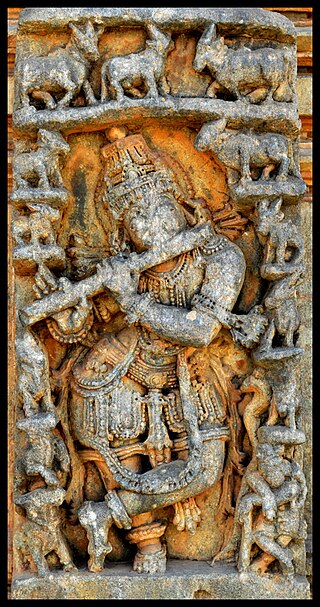
The bamboo flute, especially the bone flute, is one of the oldest musical instruments known. Examples of Paleolithic bone flutes have survived for more than 40,000 years, to be discovered by archaeologists. While the oldest flutes currently known were found in Europe, Asia too has a long history with the instrument that has continued into the present day. In China, a playable bone flute was discovered, about 9000 years old.
Nicolas Collins is a composer of mostly electronic music, a sound artist and writer. He received his BA and MA from Wesleyan University, and his PhD from the University of East Anglia. Upon graduating from Wesleyan, he was a Watson Fellow.
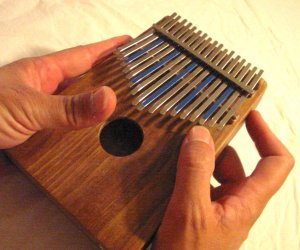
A lamellophone is a member of the family of musical instruments that makes its sound by a thin vibrating plate called a lamella or tongue, which is fixed at one end and has the other end free. When the musician depresses the free end of a plate with a finger or fingernail, and then allows the finger to slip off, the released plate vibrates. An instrument may have a single tongue or a series of multiple tongues.
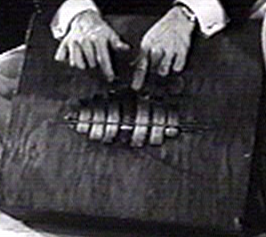
The marímbula is a plucked box musical instrument of the Caribbean. In Cuba it is common in the changüí genre, as well as old styles of son. In Mexico, where it is known as marimbol is played in son jarocho; in the Dominican Republic, where it is known as marimba, it is played in merengue típico, and in Jamaica it is known as rumba box and played in mento.

Music was ubiquitous throughout Mesopotamian history, playing important roles in both religious and secular contexts. Mesopotamia is of particular interest to scholars because evidence from the region—which includes artifacts, artistic depictions, and written records—places it among the earliest well-documented cultures in the history of music. The discovery of a bone wind instrument dating to the 5th millennium BCE provides the earliest evidence of music culture in Mesopotamia; depictions of music and musicians appear in the 4th millennium BCE; and later, in the city of Uruk, the pictograms for ‘harp’ and ‘musician’ are present among the earliest known examples of writing.
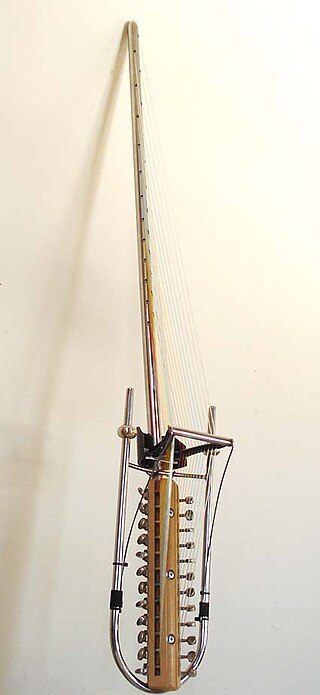
The Gravikord is a 24 string electric double bridge-harp invented by Robert Grawi in 1984, which is closely related to both the West African kora and the mbira. It was designed to employ a separated double tonal array structure making it possible to easily play cross-rhythms in a polyrhythmic musical style in a modern electro-acoustic instrument. The Gravi-kora is a similar instrument, also developed by Grawi, which is tuned identically to a traditional 21 string kora.
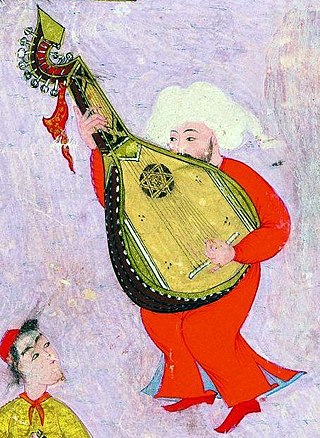
The Shahrud was a short-necked lute, illustrated in the Surname-i Hümayun, resembling an oud or barbat, but being much larger. The larger size gave the instrument added resonance and a deeper (bass) range, like the modern mandobass, mandolone or Algerian mandole.

The Yale Morris Steinert Collection of Musical Instruments, a division of the Yale School of Music, is a museum in New Haven, Connecticut. It was established in 1900 by a gift of historic keyboard instruments from Morris Steinert, and later enriched in 1960 and 1962 by the acquisition of the Belle Skinner and Emil Herrmann collections. Initially housed under the dome of Woolsey Hall, it was moved in 1961 to a historic Romanesque structure on Hillhouse Avenue, constructed in 1895 for the Alpha Delta Phi fraternity.
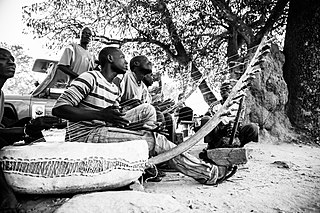
African Harps, particularly arched or "bow" harps, are found in several Sub-Saharan African music traditions, particularly in the north-east. Used from early times in Africa, they resemble the form of harps in ancient Egypt with a vaulted body of wood, parchment faced, and a neck, perpendicular to the resonant face, on which the strings are wound.

The Berlin Musical Instrument Museum is located at the Kulturforum on Tiergartenstraße in Berlin, Germany. The museum holds over 3,500 musical instruments from the 16th century onward and is one of the largest and most representative musical instrument collections in Germany. Objects include a portable harpsichord once owned by Prussia's Queen Sophie Charlotte, flutes from the collection of Frederick the Great, and Benjamin Franklin's glass harmonica.
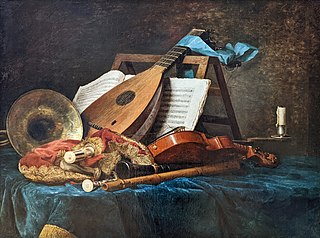
A musical instrument is a device created or adapted to make musical sounds. In principle, any object that produces sound can be considered a musical instrument—it is through purpose that the object becomes a musical instrument. A person who plays a musical instrument is known as an instrumentalist. The history of musical instruments dates to the beginnings of human culture. Early musical instruments may have been used for rituals, such as a horn to signal success on the hunt, or a drum in a religious ceremony. Cultures eventually developed composition and performance of melodies for entertainment. Musical instruments evolved in step with changing applications and technologies.

Music archaeology is an interdisciplinary field of study that combines musicology and archaeology. As it includes the study of music from various cultures, it is often considered to be a subfield of ethnomusicology.

The State Institute for Music Research is a musicological research facility in Berlin, Germany for the study of Musical Instruments, Music History, Music Theory and Music technology. It is an agency of the Prussian Cultural Heritage Foundation and operates the Berlin Musical Instrument Museum.

The angkuoch is a Cambodian jaw harp. It is a folk instrument made of bamboo or iron.
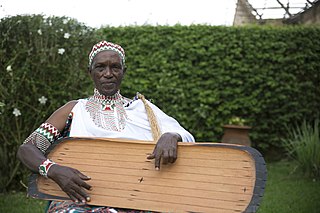
Trough zithers are a group of African stringed instruments or chordophones whose members resemble wooden bowls, pans, platters, or shallow gutters with strings stretched across the opening. A type of zither, the instruments may be quiet, depending upon the shape of the bowl or string-holder. Sound is often amplified with the addition of a gourd resonator. Instruments have been classed into five different types, based on shape.

Frame zither is a class of musical instrument within the Hornbostel-Sachs classification system for a type of simple chordophone, in which the body of the instrument is made from a frame.

The psalterion is a stringed, plucked instrument, an ancient Greek harp. Psalterion was a general word for harps in the latter part of the 4th century B.C. It meant "plucking instrument".